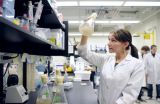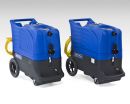(Press-News.org) Alberta's oilsands have water challenges. Oilsands development uses a vast amount of water and even though it's recycled multiple times, the recycling concentrates the toxins and metals leftover from extracting and upgrading the bitumen, resulting in tailings ponds that are both a lightening rod for controversy and a significant risk to the environment. A research project underway between biologists at the University of Calgary and engineers at the University of Alberta to help resolve the water issue is making rapid progress toward that goal.
Two years into the research, both groups are excited about their progress. A paper into the first round of research will be published in the January edition of FEMS Microbial Ecology.
Much of the research into tailings remediation has focused on microbes and their ability to settle the tailings sludge and clean the water. This NSERC-funded research is focused on a certain kind of bacterial growth called biofilms. Biofilms are everywhere in our environment, including in the plaque on our teeth and they can be very resilient, says Dr. Raymond Turner, a professor in the Department of Biological Sciences at the University of Calgary.
"We've isolated biofilms that are indigenous to the oilsands environment and are highly tolerant to the stress associated with toxins and metals found in tailings water. Those consortia of biofilms are able to, slowly, detoxify the water," says Turner, who co-leads the project with Dr. Howard Ceri, biological sciences professor at the University of Calgary.
A sample of sediment, or sludge, was taken from a tailings pond in the summer of 2009. MSc candidate and paper co-author Susanne Golby was able to successfully cultivate biofilms from the sample under a variety of different conditions.
"It was really exciting when we found that multiple different species could be recovered within one biofilm. By altering the growth conditions, and exposing the biofilms to different stressors, we could select for or against certain species and we began to learn how we could manipulate the biofilms to get the metabolic activities and characteristics we were looking for."
With the proof of principle in place, Turner and his team is now actively growing biofilms on the support material to test in bioreactors, which are being developed by professors and their graduate students in the Department of Civil and Environmental Engineering at University of Alberta.
The ultimate goal, says Turner, is to develop tailings water treatment plants for all the oilsands operations. "The plant would take all tailings water, completely clean it, and return it to the river system. Just like wastewater in Calgary is cleaned and returned to the Bow River."
INFORMATION:
Researchers develop new method of cleaning toxins from the oilsands
Ultimate goal: Tailings water treatment plants for all oil sands operations
2011-12-22
ELSE PRESS RELEASES FROM THIS DATE:
Clarke BEXT Pro Portable Extractor Delivers Superior Cleaning Power with Enhanced Cleaning Flexibility
2011-12-22
Clarke, a brand of Nilfisk-Advance, Inc., introduces the latest addition to the company's line of carpet extractors, the BEXT Pro Portable Extractor. Delivering instant, continuous heat of 212 degrees Fahrenheit solution, the BEXT Pro effectively attacks tough carpet stains. The BEXT Pro is available in two pressures--100 psi and 400 psi--in addition to models with heated and non-heated performance, providing operators with the ultimate cleaning flexibility to satisfy applications ranging from light duty cleaning to deep extraction requirements.
With a durable, user-friendly ...
Exploiting Trichoderma: From food security to biotechnology
2011-12-22
From improving food security to their use as biotechnology power horses, Trichoderma fungi are increasingly being exploited by industry. Current advances in the field are brought together and highlighted in a special issue of Microbiology published online on 27 December.
Trichoderma are free-living fungi widely used in agricultural biotechnology. Some species of Trichoderma are specifically used as biocontrol agents to control plant pathogens including Fusarium species. Their success is partly due to mycoparasitism – a lifestyle where one fungus is parasitic on another ...
Self-regulation of the immune system suppresses defense against cancer
2011-12-22
It is vital that the body's own immune system does not overreact. If its key players, the helper T cells, get out of control, this can lead to autoimmune diseases or allergies. An immune system overreaction against infectious agents may even directly damage organs and tissues.
Immune cells called regulatory T cells ("Tregs") ensure that immune responses take place in a coordinated manner: They downregulate the dividing activity of helper T cells and reduce their production of immune mediators. "This happens through direct contact between regulatory cell and helper cell," ...
Balancing the womb
2011-12-22
New research hopes to explain premature births and failed inductions of labour. The study by academics at the University of Bristol suggests a new mechanism by which the level of myosin phosphorylation is regulated in the pregnant uterus.
The researchers, Dr Claire Hudson and Professor Andrés López Bernal in the School of Clinical Sciences and Dr Kate Heesom in the University Proteomics Facility and the School of Biochemistry, have discovered that phosphorylation of uterus proteins at specific amino acids have a key role in the regulation of uterine activity in labour.
A ...
Monitoring food with millimeter waves
2011-12-22
Has the packet been properly filled? Are there impurities in the chocolate? Have the plastic seams been welded correctly? Is there a knife hidden in the parcel? Answers to all these questions are provided by SAMMI, short for Stand Alone MilliMeter wave Imager. The millimeter-wave sensor is able to see through all non-transparent materials. Researchers at the Fraunhofer Institute for High Frequency Physics and Radar Techniques FHR in Wachtberg have developed the device, whichat 50 centimeters wide and 32 centimeters high is no larger than a compact laser printer. SAMMI can ...
New Upright Vacuum from Advance Delivers Exceptional Cleaning Performance for the Hospitality Market
2011-12-22
Advance introduces the newest addition to the company's upright vacuum product line with the Spectrum 12H Single Motor Upright Vacuum. With high-quality dirt pickup and filtration capabilities, the Spectrum 12H is designed to withstand the demanding environmental conditions and the unique operational needs found in the hospitality market.
"The hospitality industry requires continuous cleaning and carpet maintenance to ensure excellent guest satisfaction," said Bob Abrams, Product Manager for Nilfisk-Advance. "The Spectrum 12H meets these requirements with ...
How to break Murphy's Law
2011-12-22
Murphy's Law is a useful scapegoat for human error: "If something can go wrong, it will." But, a new study by researchers in Canada hopes to put paid to this unscientific excuse for errors by showing that the introduction of verification and checking procedures can improve structural safety and performance and so prevent the application of the "law".
Engineer Franz Knoll of Nicolet Chartrand Knoll Ltd., based in Montreal, Quebec, writing in the International Journal of Reliability and Safety explains that faults and flaws in any industrial product almost always originate ...
Even limited telemedicine could improve developing health
2011-12-22
A lack of infrastructure in developing countries, and particularly in rural areas, often ensures that healthcare provision is absent. Research published in the International Journal of Services, Economics and Management by a team at Howard University in Washington DC suggests a solution to this insidious problem involving the development of telemedicine.
Ronald Leach and colleagues describe a highly asynchronous service model for healthcare delivery. The approach is much cheaper to implement than direct medicine and even less expensive than other approaches to telemedicine ...
Southampton researchers help to outline world's land and water resources for food and agriculture
2011-12-22
Researchers from the University of Southampton have contributed to a major international United Nation's (UN) report into the current status of the world's land and water resources for food and agriculture.
Dr Craig Hutton, Professor Mike Clark, both from the University's GeoData Institute, and demographer Dr Fiifi Amoako Johnson contributed as authors as well external editors to the recent United Nations Food and Agriculture Organisation publication, 'State of the World's Land and Water Resources for Food and Agriculture' (SOLAW).
The report notes that with the task ...
Pre-surgery exam rates vary widely among hospitals
2011-12-22
TORONTO, Ont. -- Hospitals vary greatly in the number of patients who see an internal medicine specialist before major non-cardiac surgery, with rates ranging from five per cent of patients to 90 per cent, new research has found.
The findings are important because they suggest there are no commonly agreed upon standards for which patients should have such consultations, said Dr. Duminda Wijeysundera, a scientist at the Li Ka Shing Knowledge Institute of St. Michael's Hospital and the Institute for Clinical Evaluative Sciences (ICES).
As a result, some patients may be ...
LAST 30 PRESS RELEASES:
Numbers in our sights affect how we perceive space
SIMJ announces global collaborative book project in commemoration of its 75th anniversary
Air pollution exposure and birth weight
Obstructive sleep apnea risk and mental health conditions among older adults
How talking slows eye movements behind the wheel
The Ceramic Society of Japan’s Oxoate Ceramics Research Association launches new international book project
Heart-brain connection: international study reveals the role of the vagus nerve in keeping the heart young
Researchers identify Rb1 as a predictive biomarker for a new therapeutic strategy in some breast cancers
Survey reveals ethical gaps slowing AI adoption in pediatric surgery
Stimulant ADHD medications work differently than thought
AI overestimates how smart people are, according to HSE economists
HSE researchers create genome-wide map of quadruplexes
Scientists boost cell "powerhouses" to burn more calories
Automatic label checking: The missing step in making reliable medical AI
Low daily alcohol intake linked to 50% heightened mouth cancer risk in India
American Meteorological Society announces Rick Spinrad as 2026 President-Elect
Biomass-based carbon capture spotlighted in newly released global climate webinar recording
Illuminating invisible nano pollutants: advanced bioimaging tracks the full journey of emerging nanoscale contaminants in living systems
How does age affect recovery from spinal cord injury?
Novel AI tool offers prognosis for patients with head and neck cancer
Fathers’ microplastic exposure tied to their children’s metabolic problems
Research validates laboratory model for studying high-grade serous ovarian cancer
SIR 2026 delivers transformative breakthroughs in minimally invasive medicine to improve patient care
Stem Cell Reports most downloaded papers of 2025 highlight the breadth and impact of stem cell research
Oxford-led study estimates NHS spends around 3% of its primary and secondary care budget on the health impacts of heat and cold in England
A researcher’s long quest leads to a smart composite breakthrough
Urban wild bees act as “microbial sensors” of city health.
New study finds where you live affects recovery after a hip fracture
Forecasting the impact of fully automated vehicle adoption on US road traffic injuries
Alcohol-related hospitalizations from 2016 to 2022
[Press-News.org] Researchers develop new method of cleaning toxins from the oilsandsUltimate goal: Tailings water treatment plants for all oil sands operations



